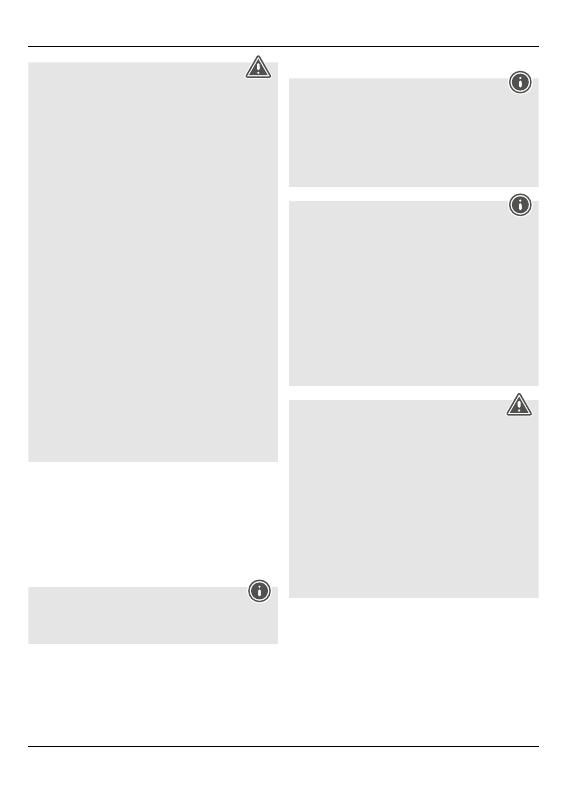
15
Avertissement - concernant les piles
•Respectez impérativement la polarité de la pile
(marquage + et -) lors de l‘insertion dans le boîtier ;
risques d‘écoulement et d‘explosion des piles si tel n‘est
pas le cas.
•Utilisez exclusivement des batteries (ou des piles) du
type indiqué.
•Avant d‘insérer les piles, nettoyez-en les contacts, ainsi
que les contacts d‘accouplement.
•N‘autorisez pas à des enfants de remplacer les piles d‘un
appareil sans surveillance.
•N’utilisez pas simultanément des piles usagées et des
piles neuves ou des piles de différents types.
•Retirez les piles des produits que vous ne comptez pas
utiliser pendant un certain temps (à l‘exception des
produits d‘alarme en veille).
•Ne court-circuitez pas les piles.
•Ne tentez pas de recharger les piles.
•Ne jetez pas de piles au feu.
•Conservez les piles hors de portée des enfants.
•Ne tentez pas d‘ouvrir les piles, faites attention à ne pas
les endommager, les jeter dans l’environnement et à ce
que des petits enfants ne les avalent pas. Les piles sont
susceptibles de contenir des métaux lourds toxiques et
nocifs pour l‘environnement.
•Retirez les piles usagées immédiatement du produit pour
les recycler.
•Évitez de stocker, charger et utiliser le produit à des
températures extrêmes et à une pression atmosphérique
extrêmement basse (à haute altitude, par exemple).
4. Mise en service
4.1. Station de mesure
•Ouvrez le couvercle du compartiment des piles.
•Réglez le canal (32) de votre choix avec le commutateur. Si
vous utilisez un seul émetteur, laissez-le réglé sur "1".
•Insérez 2 piles AAA neuves de 1,5 V en respectant la polarité
correcte.
•Refermez le couvercle du compartiment des piles et placez
l’appareil dans l’endroit de votre choix.
Remarque
Lors de la première mise en service, veuillez premièrement
insérer les piles dans la station de mesure, puis dans la
station de base.
4.2. Station de base
• Ouvrez le compartiment à piles (28) et insérez deux piles
AAA conformément aux indications de polarité. Refermez le
couvercle du compartiment.
5. Installation
Remarque - concernant l‘installation
•Nous vous recommandons de positionner la station de
base et la station de mesure dans les endroits envisagés
sans effectuer le montage, puis d‘effectuer les réglages
tels que décrits au chapitre 6. (fonctionnement
des stations).
•Procédez ensuite à l‘installation des stations après avoir
effectué le réglage et reçu une connexion radio stable.
Remarque
•La portée de la transmission radio entre la station de
base et la station de mesure est de 30 m dans un espace
dégagé.
•Veuillez contrôler, avant l‘installation, que la portée
radio ne soit pas altérée par des interférences ou des
obstacles tels que bâtiments, arbres, véhicules, lignes
haute tension, etc.
•Veuillez contrôler, avant l‘installation dénitive, la bonne
qualité de la transmission entre les deux stations.
•Veuillez également protéger les stations de l‘ensoleillement
direct et de la pluie lors de l‘installation.
•La hauteur standard internationale de mesure de la
température de l‘air est de 1,25 m (4 ft) au-dessus du sol.
Avertissement
•En vue de l‘installation, procurez-vous le matériel
d‘installation adéquat pour le mur concerné dans un
commerce spécialisé.
•Veuillez contrôler que l‘emballage ne contienne aucune
pièce erronée ni endommagée.
•N‘appliquez en aucun cas une force excessive lors
de l‘installation. Une force excessive est susceptible
d‘endommager le produit.
•Avant l‘installation, vériez que le mur prévu pour recevoir
le produit dispose d‘une force portante susante et
qu‘aucune conduite d‘électricité, d‘eau, de gaz ni aucune
autre conduite ne passe dans cette partie de la cloison.
•N‘installez pas le produit à un endroit où des personnes
sont susceptibles de se tenir.
5.1. Station de base
•Placez la station de base sur une surface plane à l‘aide de
son pied.
5.2. Station de mesure
•Vous pouvez également placer la station de mesure à
l‘extérieur, sur une surface plane, à l‘aide de son pied.
•Nous vous recommandons d‘installer solidement la station de
mesure à une paroi extérieure à l’aide de l’encoche (31).
•Fixez cheville, vis, clou, etc. dans la paroi prévue pour recevoir
l‘installation.



















